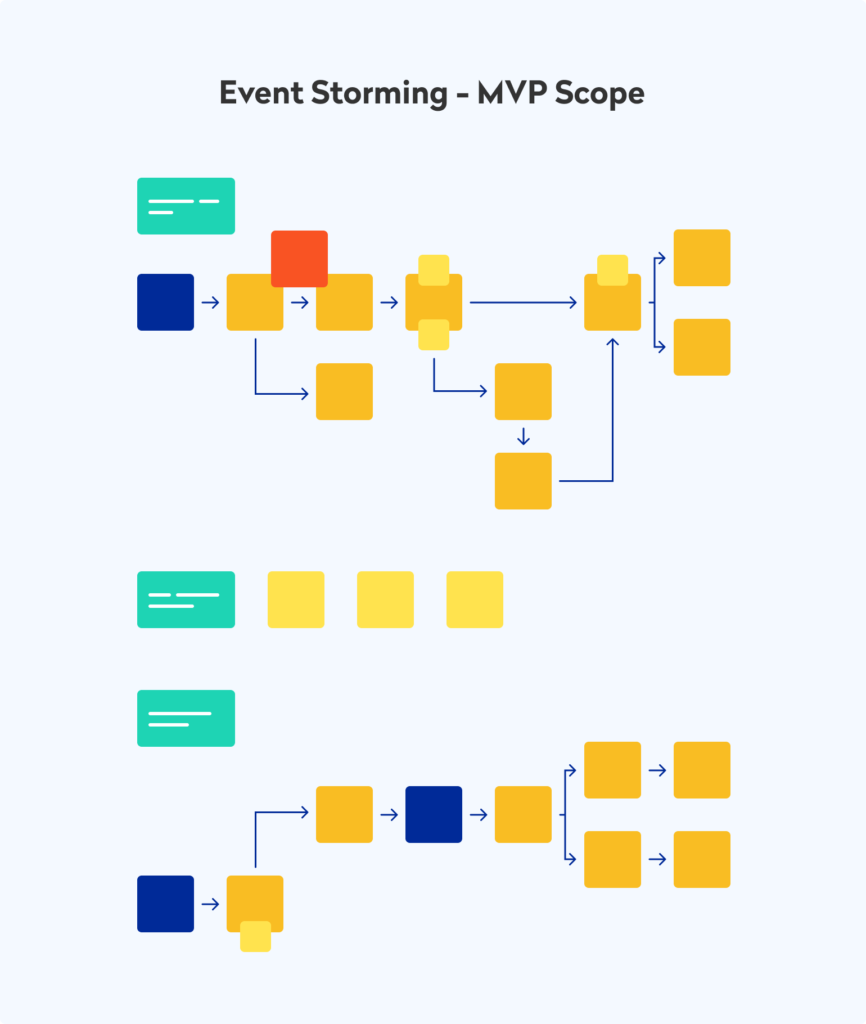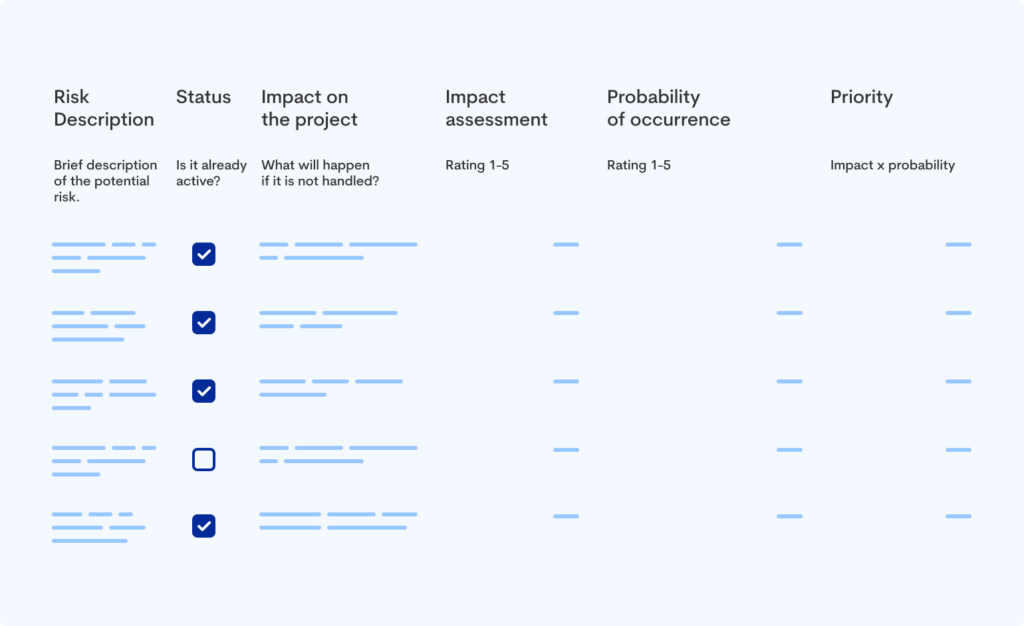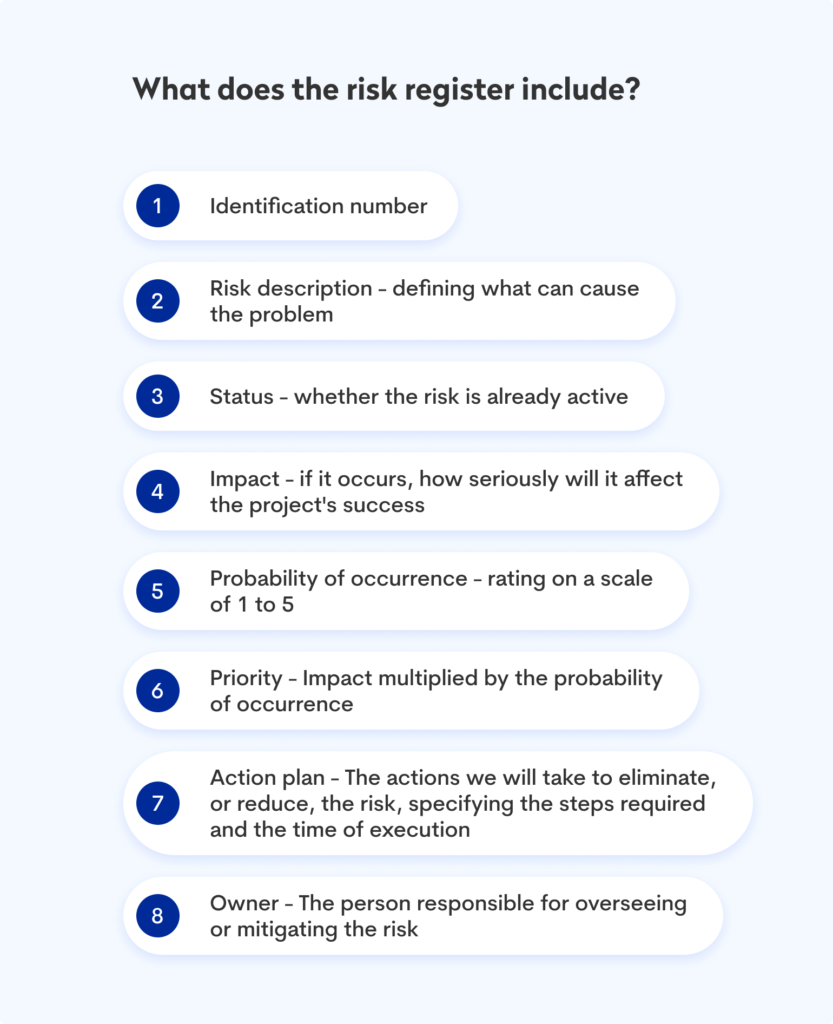Risk analysis is a component of project management that allows you to prepare for unplanned situations during work execution. Due to the complexity of the application’s functionality and processes, a well-formulated risk register is vital in order to maintain complete control over what happens in the project.
While we have no control over future contingencies, we can implement an extremely helpful tool that minimizes the impact of potential problems on the project. Analyzing project risks – and planning how we will handle them – helps maintain the project schedule and increases the chances of successfully delivering the intended scope.
In this article, we look closely at a risk register and how we use it in project management.
What is a risk register?
A risk register, sometimes called a risk log, is a tool for identifying and monitoring any risks that may affect a project. If adequately prepared, it helps keep track of problems and addresses them on time. It is easily modifiable, contains specific and understandable information, and focuses on what is most important at the time.
A risk register is usually created in the early stages of a project and, through intentional monitoring and control of events, is regularly updated throughout the project.
Product workshops help the team understand project risks
A risk register is a document created, among other things, as a result of a pre-implementation analysis. During the productive workshop, we analyze the risks that may arise during the project.
Preparing a project risk register involves the entire team, which has detailed insights into their specific areas of responsibility. During the product workshops, we brainstorm all risks that can affect the project, drawing on expertise and experience. During such meetings, we also talk with stakeholders to understand their concerns and clarify any risks that may arise in the project.
In the part of the workshop „Event Storming” (or meetings), aimed at analyzing product performance, we prepare a visualization of the functionality processes. Using colored post-it notes, we write down various events that occur during the operation of the application, such as „a ticket has been bought,” „a seat has been reserved,” and „a payment model has been selected.” We then name each event in the application, answering the question, „What event took place in the domain?”
At this point, there are always so-called „hot spots” or „red cards” with possible risks. They can refer to various situations, such as it is unclear at the moment what the functionality should look like or the legal aspects of implementing a module are unknown. We record all preliminary information on a sheet, specially prepared for the risk register.
 What does the project’s risk register include?
What does the project’s risk register include?
The risk register template is extremely easy to set up and can be created using an Excel spreadsheet or other more specialized software.
 The information included in the registry:
The information included in the registry:
- Identification number
Facilitates quick reference or identification of each risk.
- Risk description
This is a detailed description of the essential elements that define the risk. The idea is to be as specific as possible about what can cause a problem. Although the risk identification process is done early in the project, risks change over time and new risks may emerge. Therefore, it may be necessary to perform the risk identification process multiple times throughout the project.
- Status – determines whether the risk is already active
- Impact – if a threat occurs, how seriously it will affect the success of the project
- Probability of occurrence – rating, on a scale of 1 to 5, how likely the risk is to occur
We use the simplest and most common form of qualitative assessment to calculate risk probability. We rate it, for example, on a scale of 1 to 5, based on experience and the basic data we collect. Some identified risks, such as delaying progress from one day to the next, will have little impact on the project. Others, however, could be potentially catastrophic if not properly managed.
- Priority – Impact multiplied by the probability of occurrence
The assessment of risk is usually probability multiplied by the impact. If the probability is high (4) and the impact is medium (3), your rating would be 12 (4 x 3). This method provides a simple way to quickly sort and prioritize risks.
- Action plan
The actions we would take to eliminate or reduce the risk and determine the required steps and execution time.
- Owner – The person responsible for overseeing or mitigating the risk
The final step is to assign a task owner to each risk. For most projects, it is the responsibility of the project manager to create and update a risk register. This does not mean he/she is responsible for identifying or taking action on all risks. Every member of the project team is involved in identifying and assessing risks.
 Project risk analysis – why is it important?
Project risk analysis – why is it important?
As we have already mentioned, the purpose of the register is to identify, record and track potential project risks. Creating this document is essential because – as projects become more extensive, longer and more complex – it becomes increasingly difficult to control every aspect of operations.
The primary benefit of risk management is to contain and mitigate anything that could jeopardize project success. This requires identifying problematic situations in advance and planning activities to minimize the impact of risks on the project.
If risks are not regularly analyzed and reviewed, something important might be overlooked or forgotten. The advantage of having a project risk register is that you will understand the real impact of problems on the project – and your business.
Work with an experienced project team
An experienced team not only has the technical expertise, but also has a complete picture of the project for its duration. If new risks arise, the risk register is kept up to date. Specialists with the specific project knowledge can efficiently determine what action to take on a given risk and whether that risk can be minimized or removed altogether.
On the other hand, it may turn out that a particular risk is of minor importance and can be accepted in the project. These and other conclusions come from the knowledge and experience of the technical team. For our teams, a comprehensive understanding of the possible risks that may arise in an application is crucial for the project work to go smoothly and safely.
Are you wondering how a pre-implementation analysis with a risk register can affect the success of your project? Do you want to proceed effectively with the application development process? Contact us; we will help you successfully build your product and answer your questions about your project analysis.


